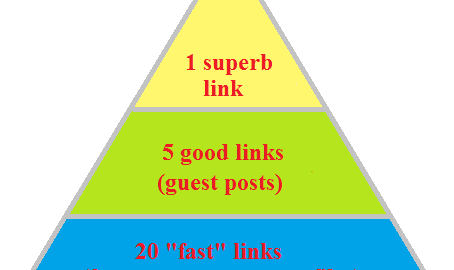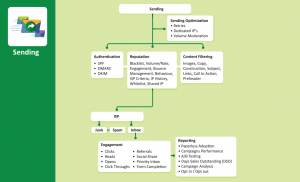It seems to be absolutely clear what white-hat link-building is. But it’s not always that easy. It is hard to build links in the most natural way.
Struggling and looking for a balance in my backlink profiles, I finally build a structure that guides me really well. I’m happy to share it with you.

The Layers
1. Get one really cool link! Sites like Forbes, HuffingtonPost, Entrepreneur, Inc etc. It’s really hard to get one but it’s definitely worth it!
Note: after Step 1 you’ll see many organic links, but don’t stop there — you still need to do some work!
2. Gain 5 nice links from more niche-specific or young sites. Their Domain Authority can be high but their traffic is usually significantly lower.
3. These ones are much easier to get, but still, I don’t recommend to buy trash links for this purpose. It’s better to build some yourself and make sure your donors are trustful and not spammy.
Why This Works
Let’s look at how links emerge in the real world.
I’m going to walk you through how backlinks are supposed to appear organically, without any efforts from marketers or SEO gurus.
This will help you understand how to imitate this process and make Google and other search engine believe your project is cool enough to rank.
The Media Event
Just imagine: some really really cool tool or service has launched. Let’s call it LinksKing: it automatically builds super links all by itself — all you need to do is press the “OK” button and pay $10 per year. What would happen next?
The founders might go to ProductHunt and other similar outlets to kick off their relations with the audience.
- Notice: Both the launch and submission to ProductHunt are media events.
You too can also have such events, like being ranked in some list by Forbes or starting a free education program. You can even create a really cool infographic or checklist – not as resounding events as the others but they will work as well .
Getting Featured
After hearing about your incredible product, Forbes, Entrepreneur and Inc follow up with reviews and coverage. Smaller and more niche resources like Tech.co, Noobpreneur, and others make their posts. And we’re not talking about guest posting here – in the ideal world these posts show up themselves.
- Notice: …but what you, as an SEO master, should do is definitely guest post. Also reach out to independent bloggers and ask for a review. Compose a really good non-advertising pitch, asking for an honest review. (This covers how to do that the right way)
Going Social
So you’re reading an article on Forbes and you get really excited about LinksKing. What luck! There are the social buttons! The article is shared on Facebook, Twitter, Linkedin. Some send the link directly to some of the closest friends and colleagues.
- Notice: there is no magic advise here… just start social activity and don’t get shy of advertising on Twitter and Facebook – it’s an unknown field for many of us, but it doesn’t mean we should neglect the opportunities it provides.
Discussions & Comments
In the appropriate sub-reddits people are talking about LinksKing. Questions about it appear on Quora. Elsewhere there are forum discussions. It’s mentioned in several comments on blog posts about link building tools.
- Notice: this is where “spam” comments, forum replies, discussion seeders, etc. come in.
Conclusion
That’s it! This where the pyramid comes from! When you are done with the first run of the pyramid, you can create much more.
Good luck and feel free to post your questions and remarks in the comments!
Hand-Picked Related Articles:
- The Tactical Guide To Promoting Your Content
- Guide To Cleaning Up Your Bad Backlinks
- Strategies for Securing Ratings and Reviews – Honestly
* Adapted lead image: ![]() Public Domain, pixabay.com via getstencil.com
Public Domain, pixabay.com via getstencil.com
The 3 Layer Approach Of Pyramid White-Hat Linkbuilding
The post The 3 Layer Approach Of Pyramid White-Hat Linkbuilding appeared first on Search Engine People Blog.
Search Engine People Blog(54)
Report Post








